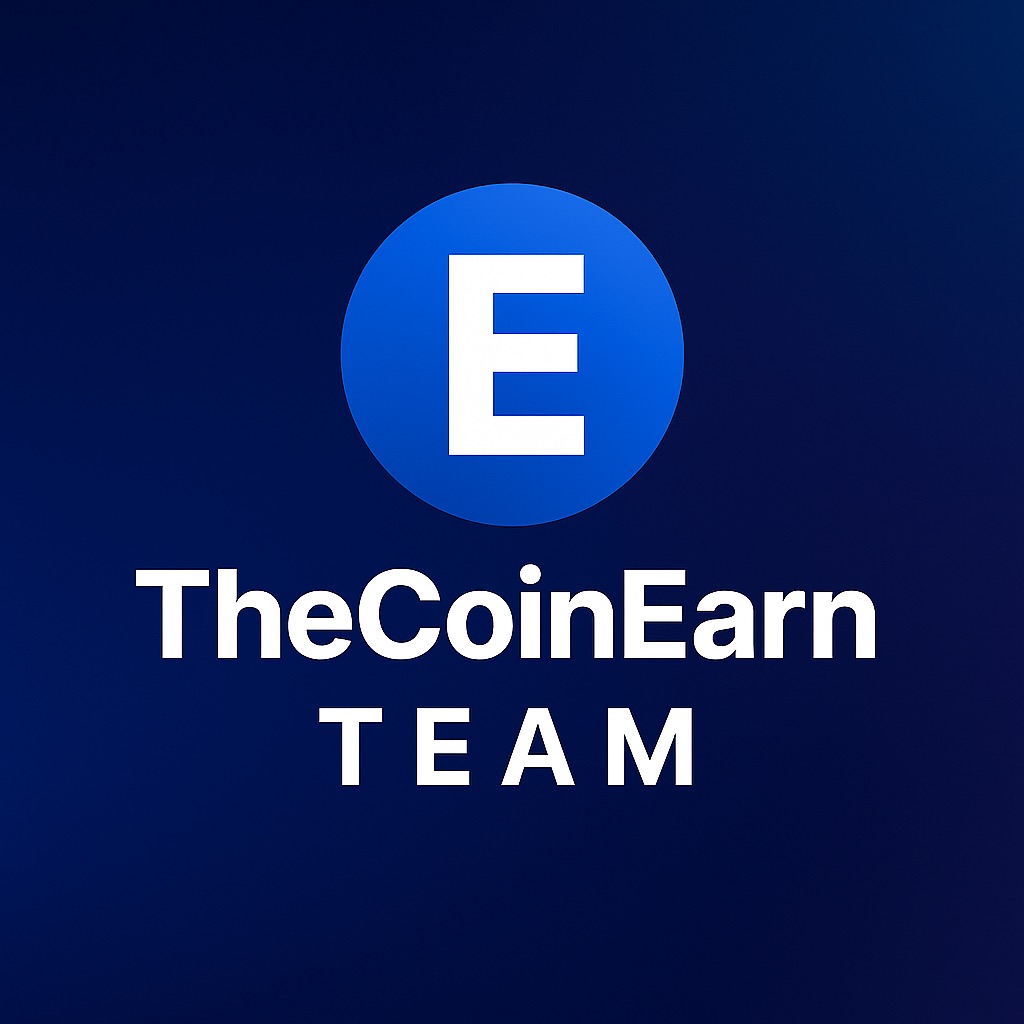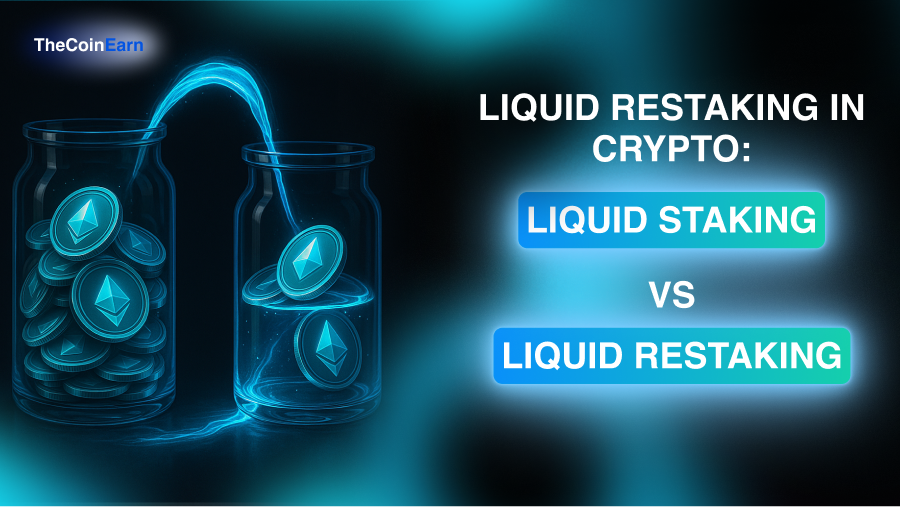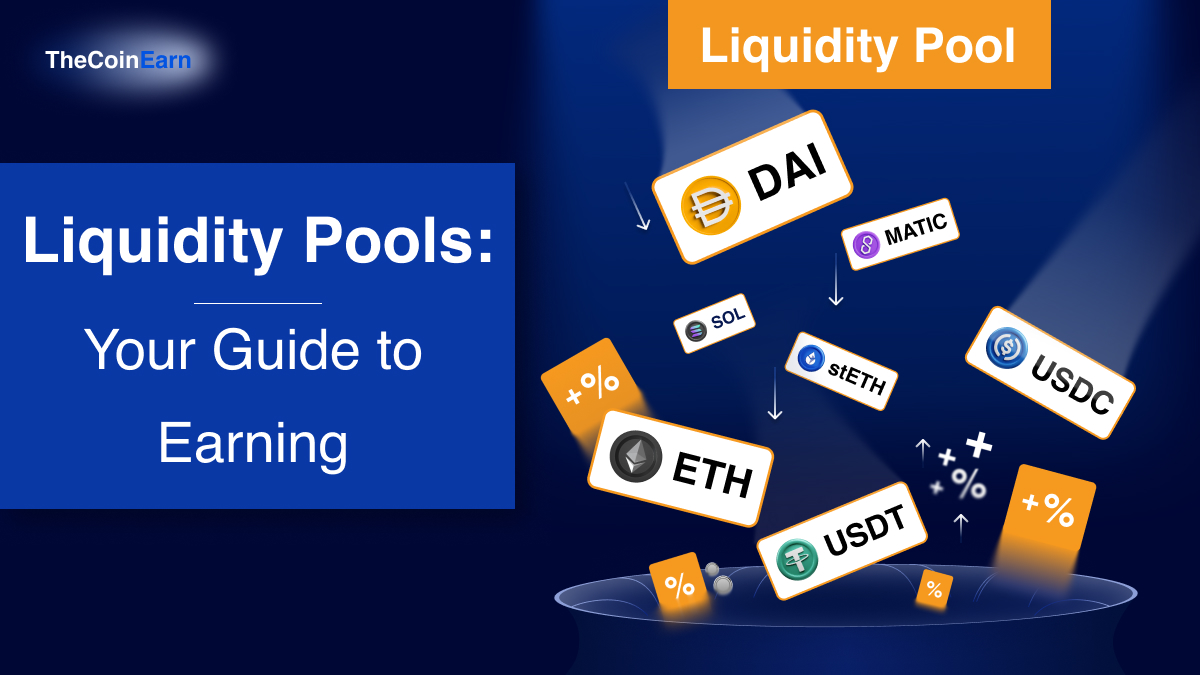NFT Staking in 2025: Real Talk on NFTs That Actually Earn
The first non-fungible token (NFT) appeared in 2014. Called Quantum, it was a video clip with a pixelated octagon that changed color and shape. This first “monetized graphic” was sold for $4. In 2025, NFTs mean something different – they are full-fledged digital assets used in the gaming economy, real-world asset (RWA) tokenization, DeFi ecosystems, and DAO management. NFT staking is the way for you to unlock the real value of your digital goods. It allows you to earn passive crypto income, access token-gated opportunities, or even use NFTs as collateral for a loan.
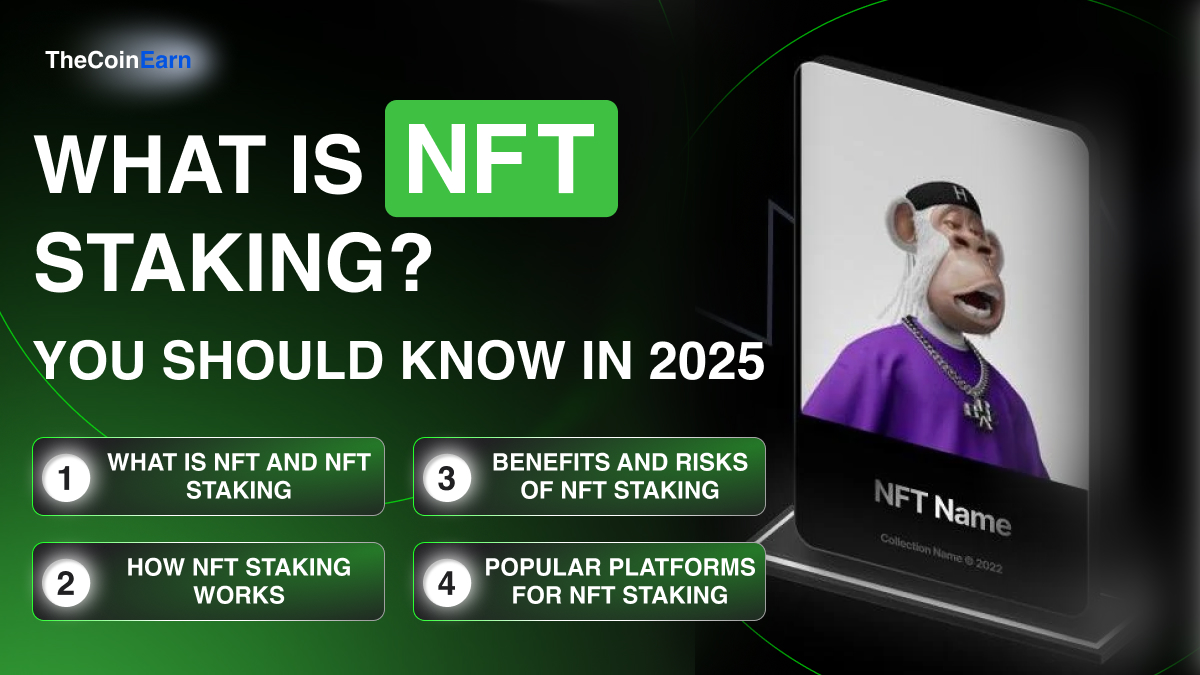
Updated Article: July 25, 2025
This guide is for you if:
- You want to earn yield on NFTs instead of flipping them.
- You’re curious about how to stake NFTs on top platforms.
- You wonder if you can stake NFTs for rewards.
- You’re looking for the best NFTs for passive income in 2025.
So today you’ll learn:
- How NFT staking works across different blockchains.
- What are the pros of staking your NFTs.
- What risks you need to manage.
- Which platforms are leading the charge in 2025.
- How to start staking safely and smartly.
Let’s turn those JPEGs into something that earns.
What is NFT Staking?
So what does staking an NFT mean? In simple terms, NFT staking means locking up your NFT on a specific platform or a blockchain-based smart contract to earn a variety of rewards — like crypto tokens, exclusive access, staking incentives, or governance rights. To be precise, this process allows you:
- Generate yield in native or partner tokens.
- Get early access to new collections.
- Participate in protocol governance.
- Secure airdrops or whitelist spots.
- Borrow against NFTs or use them as DeFi collateral.
It’s the Web3 version of earning passive income with NFTs.
When you stake your NFT, you’re essentially contributing it to a platform’s ecosystem. The platform might use your NFT to secure a network, boost a game’s economy, or reward loyalty. Either way, you earn passive income without selling or flipping your NFT. Just like how banks give you interest for locking your money in savings, staking NFTs generates yield — often between 5% and 28% APY. The process is now supported on Ethereum, Solana, Polygon, and emerging chains like Arbitrum and BNB Chain.
This isn’t just about JPEGs. In 2025, staked NFTs now represent:
- In-game characters and assets.
- Virtual real estate.
- Real-world tokenized assets (RWAs) like homes, vehicles, and art.
- Proof of participation or membership in DAOs.
- Wrapped validator nodes (via EigenLayer, Babylon Chain, etc.).
Example: In the GameFi ecosystem Parallel, players stake NFT cards to unlock deck-building advantages and token rewards. In NFTfi, users stake high-value art NFTs to access short-term ETH loans.
Unlike staking fungible tokens (like ETH or SOL), NFT staking depends on the value, rarity, and utility of each individual NFT. You don’t just stake a number — you stake a unique asset.
Staking Mechanisms
There are many types of staking mechanisms today:
- Direct NFT staking — lock your NFT into a pool and earn over time.
- Validator NFT staking — stake ETH or BTC and get NFTs that represent validator rights.
- Liquid staking — Stake and receive a tradable token that mirrors your NFT’s value.
- Fractional staking — co-own a high-value NFT with others and share staking rewards.
- RWA staking — stake NFTs tied to real-world assets like property or art and get income.
How Does NFT Staking Work?
Here’s how it usually works, or how to earn yield on staked NFTs:
- Pick an NFT (must be supported by the staking platform and eligible for staking, like game cards, art NFTs, and DAO passes).
- Go to an NFT staking platform like NFTfi, MOBOX, or Dynamic.xyz.
- Connect your wallet to the platform (MetaMask, Phantom, etc.).
- Stake your NFT (approve the staking contract, lock it in).
- Earn rewards over time (APY depends on the platform).
- Unstake when you want, get back NFT + rewards.
Remember: While staked, your NFT is locked and cannot be sold or transferred — unless you’re using liquid staking. This way, you get a wrapped token (e.g., sNFT, vToken, or stNFT) that you can use in DeFi or trading.
NFT Staking vs Crypto Staking
Here is a quick comparison of the difference between NFT staking and crypto staking to help you understand the point better.
| Aspect | NFT Staking | Crypto Staking |
| Asset type | Unique NFTs | Fungible tokens (e.g., ETH) |
| Rewards basis | Utility, rarity, project mechanics | Amount staked, validator performance |
| Flexibility | Depends on project/platform | Generally standardized |
| Risk profile | Higher (due to volatility & platform) | Lower (especially with major tokens) |
Have any questions about crypto staking? Check out our article, and you will find all the answers from our experts.
Benefits of Staking NFTs
The biggest advantage of NFT staking is simple: passive income. But that’s just the start.
Earn without selling
NFT staking allows you to earn yield without selling your assets. This means long-term holders can get consistent returns while keeping future upside. Whether you’re holding NFTs for sentimental value, rarity, or long-term investment, staking lets you turn dormant assets into productive tools.
Utility access
Many platforms reward stakers with more than just tokens. Staking often unlocks gated benefits like whitelist spots for upcoming NFT mints, exclusive airdrops, early access to product releases, or premium community memberships. Some GameFi projects give in-game boosts, while DAO projects give voting rights or governance proposals to active stakers. So you could potentially have a say in the future of the protocol.
Collateralization
NFTs can now be used as collateral to take out loans, so you don’t have to sell your prized assets. Platforms like NFTfi make this possible. This is especially useful for high-value NFTs like CryptoPunks or BAYC assets, so you can reinvest borrowed capital elsewhere.
Liquidity solutions
For users struggling with NFT illiquidity, staking can provide solutions via tokenization. Platforms like NFTX convert NFTs into ERC-20 tokens that can be traded in liquidity pools, so you have an exit strategy or temporary liquidity without selling the original NFT.
Gated content
Beyond financial gain, some platforms reward NFT stakers with access to premium content. This includes exclusive webinars, digital merch, event invites, or private Discord channels — all to deepen engagement and reward long-term commitment.
Platforms like Parallel, Illuvium, and Marinade have unique staking structures that can outperform DeFi APRs.
Risks to Watch For
Smart contract vulnerabilities
Smart contracts are the backbone of NFT staking, but if not audited, can be exploited by hackers. Millions have been lost in DeFi exploits due to bugs or poorly written code. Always choose platforms that publish audit reports from reputable firms.
NFT & Token volatility
NFT markets are super volatile. While staking rewards may be attractive, the underlying NFT or reward token could lose value. For example, a high APY reward token could rapidly depreciate and offset your earnings.
Liquidity & redemption risks
When you stake an NFT, it’s locked for a certain period. So you can’t sell or move it until the staking term ends. In some cases, like NFTX, you may not get the exact same NFT back, which is a concern for holders of rare or unique tokens.
Platform dependency
Relying on new or unverified platforms can be risky. If a platform goes down, gets hacked, or rug pulls its users, your NFTs may be lost forever. Stick with platforms that have proven longevity, transparent teams, and community trust.
How to Protect Yourself:
- Use platforms with CertiK, DeFiSafety, or RugDoc audits (to check security).
- Read the staking terms and understand the APY model.
- Diversify across multiple platforms or NFT types.
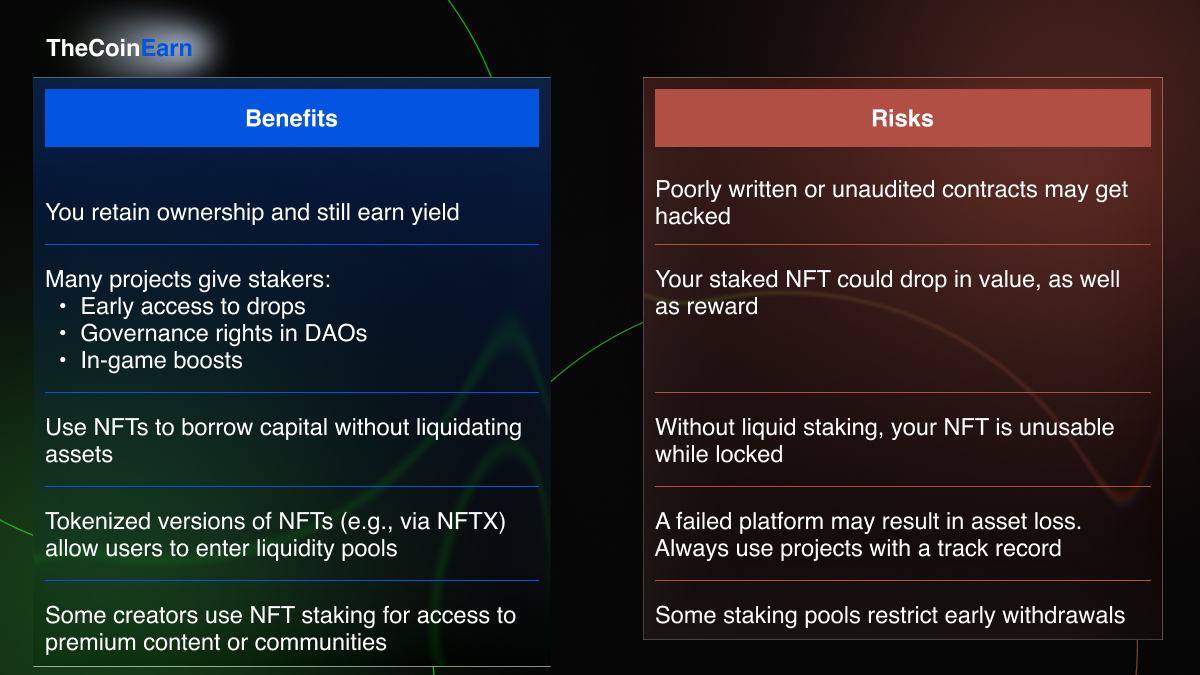
Top NFT Staking Platforms in 2025
NFTfi
✅Use case: Loans + rewards
✅ Audited: Yes (CertiK)
✅Chain: Ethereum
✅Reward: ETH loans + token bonuses
NFTfi is one of the original and most trusted platforms where you can use your NFTs as collateral for crypto loans — and now it also supports NFT staking with real rewards. It’s peer-to-peer, so borrowers and lenders negotiate terms directly. Perfect for users who hold valuable NFTs but don’t want to sell them. Instead of flipping, you can stake your NFT for passive income or to unlock liquidity.
Here’s how it works: You list your NFT on NFTfi’s platform and either receive a loan offer or enter into a staking contract where your NFT generates yield over time. You can also lend to others and earn interest on their staked NFTs.
The NFT is held in escrow during the loan term. If the borrower repays, they get their NFT back; if not, the lender keeps it. NFTfi supports major collections like Bored Ape Yacht Club, Doodles, and Azuki.
Main benefits:
- Use high-value NFTs (like Bored Apes, Azukis, etc.).
- Get ETH loans and platform token rewards.
- Choose loan terms or earn by providing capital.
Risks:
- Your NFT is locked in a smart contract — defaulting on a loan may lead to permanent loss.
- Requires solid knowledge of loan terms and APY rates.
Good for: collectors, DeFi users, and long-term holders.
MOBOX
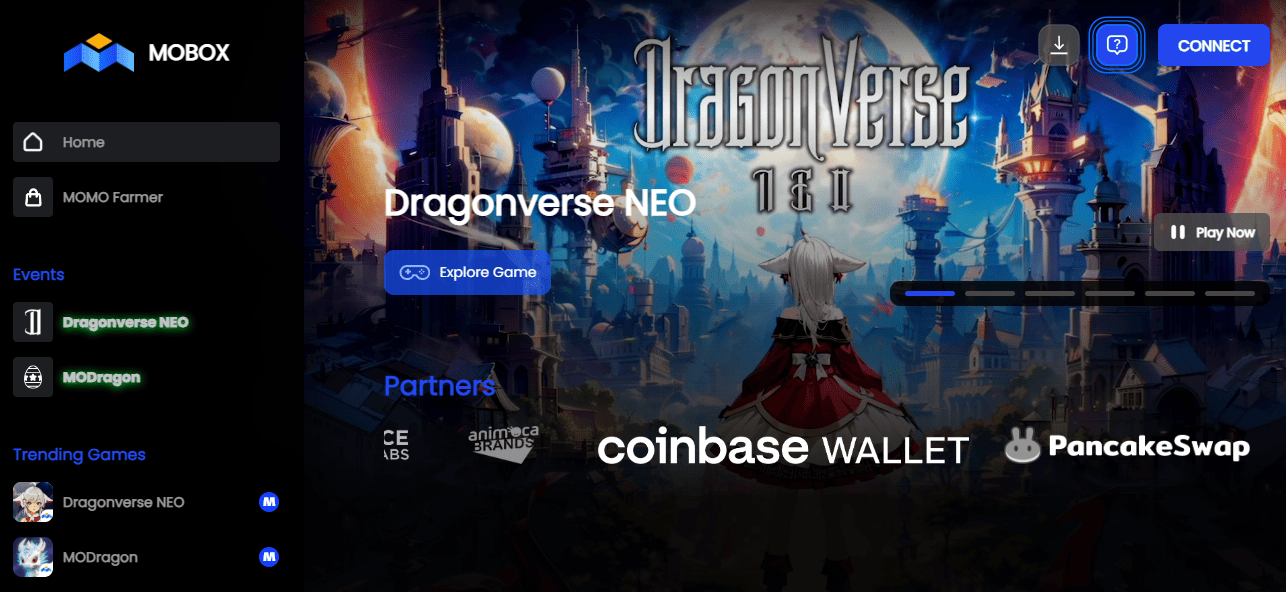
✅Use case: Gamified DeFi
✅Audited: Partially
✅Chain: BNB Chain, ETH
MOBOX is a gamified DeFi platform on the BNB Chain that combines yield farming with NFT utilities. Inside its ecosystem, you can stake MOMO NFTs to earn MBOX tokens and play fun, skill-based games.
MOMOs have different rarities and hash power — the more powerful your NFT, the more rewards you can generate. The platform also runs special events where stakers get exclusive NFT drops, skins and early game access.
MOBOX creates an NFT staking system where the utility of the NFTs goes way beyond yield generation. Its multichain support and gamified structure is for users who want to earn while engaging with interactive environments. With frequent competitions and seasonal updates, MOBOX is one of the most active NFT staking ecosystems in 2025.
Main benefits:
- Stake NFTs to earn MBOX and bonuses.
- Gamified staking encourages activity.
- Play-to-earn mechanics built-in.
Risks:
- MBOX token price is volatile.
- Some NFTs have better yield than others — performance varies.
Good for: casual gamers, NFT flippers and DeFi fans.
Parallel
✅Use case: Gaming + earning
✅Audited: Yes
✅Chain: Ethereum, Polygon
Parallel is a GameFi project and one of the most polished trading card games in Web3. You can stake NFT cards to earn $PRIME token, get gameplay boosts and early access to seasonal rewards.
Staking in Parallel is pretty simple. You choose which cards you want to stake (rarity plays a big role), deposit them into your staking pool and start earning based on their strategic value and activity in the ecosystem. If you’re actively playing, staking can give you a serious edge.
Parallel bridges entertainment and finance, making it one of the most fun staking platforms for NFT gamers.
Main benefits:
- Top-tier GameFi ecosystem.
- Earns with gameplay perks.
- PRIME token can be traded or used in-game.
- High APY on rare or Genesis cards.
Risks:
- Card prices can fluctuate based on game meta.
- You may miss out on trading opportunities while staked.
Perfect for: GameFi players, traders, and collectors.
NFTX
✅Use case: Liquidity + passive income
✅Audited: Yes
✅Chain: Ethereum
NFTX is all about unlocking liquidity for your NFTs — especially blue-chip NFTs like CryptoPunks or BAYC. It lets you tokenize your NFT into ERC-20 tokens (called vTokens) and earn rewards by staking them in vaults.
Here’s how it works: You deposit your NFT into a pool, receive vTokens in return, and can stake those tokens to earn fees from trading activity. It’s a more DeFi-focused way to make NFTs yield-generating.
While this process is technically different from traditional staking, it offers similar yield-generating potential through pool rewards and LP incentives. The trade-off is that users may not receive the exact NFT they deposited, as vaults return any NFT of equal value. NFTX is ideal for holders of floor-value NFTs looking to unlock liquidity or participate in DeFi without selling.
Main benefits:
- Turn NFTs into liquid assets.
- Stake to earn fees and governance tokens.
- Access fractional ownership of high-value collections.
Risks:
- When redeeming, you may not get your original NFT back — just one from the pool.
- Value of vTokens depends on overall vault activity.
Great for: DeFi users, liquidity seekers, and NFT investors.
Dynamic.xyz
✅Use case: Loyalty + gamification
✅Audited: Yes
✅Chains: Ethereum, Polygon
✅Unique: NFTs evolve over time and improve yields.
Dynamic.xyz brings something new to the table — Dynamic NFTs that change based on your actions. When you stake your NFTs on this platform, you’re not just earning rewards; your NFTs can actually change and level up over time. This is perfect for users who want to build digital identities or engage in loyalty ecosystems.
For example, staking a Dynamic NFT might unlock new art traits, voting rights or higher rewards the longer you hold and interact. You can even use these evolving NFTs as your profile badges in Web3 platforms. Dynamic.xyz offers platforms and brands a way to drive continuous engagement and reward user loyalty.
Main benefits:
- Unique behavior-based staking system.
- NFTs level up as you interact with the ecosystem.
- Great for brand loyalty, DAO rewards, and gamified access.
Risks:
- The value of Dynamic NFTs is harder to evaluate in traditional markets.
- Long-term engagement may be needed to unlock full benefits.
Ideal for: Web3 natives, DAO members, and collectors interested in identity
Comparison Table: NFT Staking Platforms
| Platform | Main use case | Rewards | Risk level | Chain | Special feature |
| NFTfi | Lending + staking | ETH + bonuses | Medium | Ethereum | NFTs as loan collateral; Customizable terms |
| MOBOX | Gamified DeFi | MBOX tokens | Low–Medium | BNB, ETH | MOMOverse ecosystem, multi-chain support; Skill-based games + NFT boosts |
| Parallel | GameFi cards staking | PRIME tokens | Medium | Ethereum, Polygon | Card-based NFT ecosystem (Play-to-earn meets staking) |
| NFTX | Vault-based staking/liquidity | ERC-20 tokens | High | Ethereum | ERC-20 tokenization of NFT collections |
| Dynamic.xyz | Dynamic NFT gamification | Custom tokens | Low–Medium | Multichain | Behavior-based rewards (NFTs level up as you engage) |
How to Calculate NFT Staking Rewards?
NFT rewards are calculated based on several factors that could include token uniqueness, NFT marketplace transaction volume, and the assigned value of digital assets by their creators.
- The first factor is token uniqueness. Each NFT has distinct information that makes it different from any other token thus contributing to its value and rewards. Higher uniqueness means higher value and more rewards.
- The next in the NFT staking rewards calculation is the NFT marketplace transaction volume. In other words, the more successful an NFT marketplace is in terms of transaction volume, the higher the chances NFT holders on that platform will get attractive rewards.
- Finally, the value assigned to digital assets which depends on NFT creators. Higher value assets yield more rewards given their high demand and market value.
What to Know About NFT Staking This Year
Our team has researched several trends in this space. If you want to earn passive income with NFTs, here are the things you need to know.
Dynamic NFTs (dNFTs)
NFTs can now evolve based on user actions, time, or external data. This has increased staking utility:
- Revise Protocol allows developers to update NFT metadata in real-time.
- GameFi projects like Illuvium use dNFTs to represent upgradable in-game assets.
Fractionalization & shared ownership
- NFTs can be split into ERC-20 tokens so multiple people can share ownership and rewards.
- Fractional.art and Unic.ly make high-value NFTs (like Bored Apes) accessible to groups.
NFTs as collateral (DeFi meets NFTs)
- You can now stake NFTs as collateral for loans:
- NFTfi and Astaria let you borrow ETH/USDC using your NFT as collateral.
- Platforms use NFT staking contracts to manage risk and repayments.
GameFi & Metaverse integration
Game-based staking is booming:
- Parallel: Stake NFT cards for PRIME token rewards.
- MOBOX: Gamified staking in its MOMOverse metaverse.
Tokenized Real-World Assets (RWAs)
NFTs represent fractionalized ownership of:
- Real estate: RealT
- Fine art: Particle
- Luxury cars and goods.
Staking tokenized RWA NFTs will grow as regulatory clarity comes in the US and EU.
Multichain NFT Staking
NFT staking platforms now support multiple chains:
This means composable aggregators — tools that unify staking across chains.
Compliance & security
AML/KYC regulations are getting stricter. High value NFT staking platforms must comply with:
- FATF guidance
- SEC classification risks.
Always verify if a platform uses audited smart contracts.
Conclusion
In 2025, NFT staking is a fundamental part of the Web3 economy that combines profit, gamification, and ownership. Dynamic NFTs, DeFi-collateral models, and multichain tools are pushing this ecosystem forward. The opportunities are bigger and more diverse than ever. So if you ask: Is NFT staking profitable? Yes, it is.
But with rewards come risks. Therefore, if you’re ready to earn passive income from NFTs, always research the platform that fits your goals, verify smart contract integrity, and only stake assets you’re willing to lock. NFT staking isn’t just an investment — it’s your way to shape the decentralized future.
And again, and again – stake smart, stake safe, and make your NFTs work for you.
Before the start:
- Know your NFT’s use case (game, governance, art, RWA).
- Check platform audits and reviews.
- Compare yields vs risk (not all APYs are created equal).
- Understand withdrawal terms (some lockups are flexible, some fixed).
